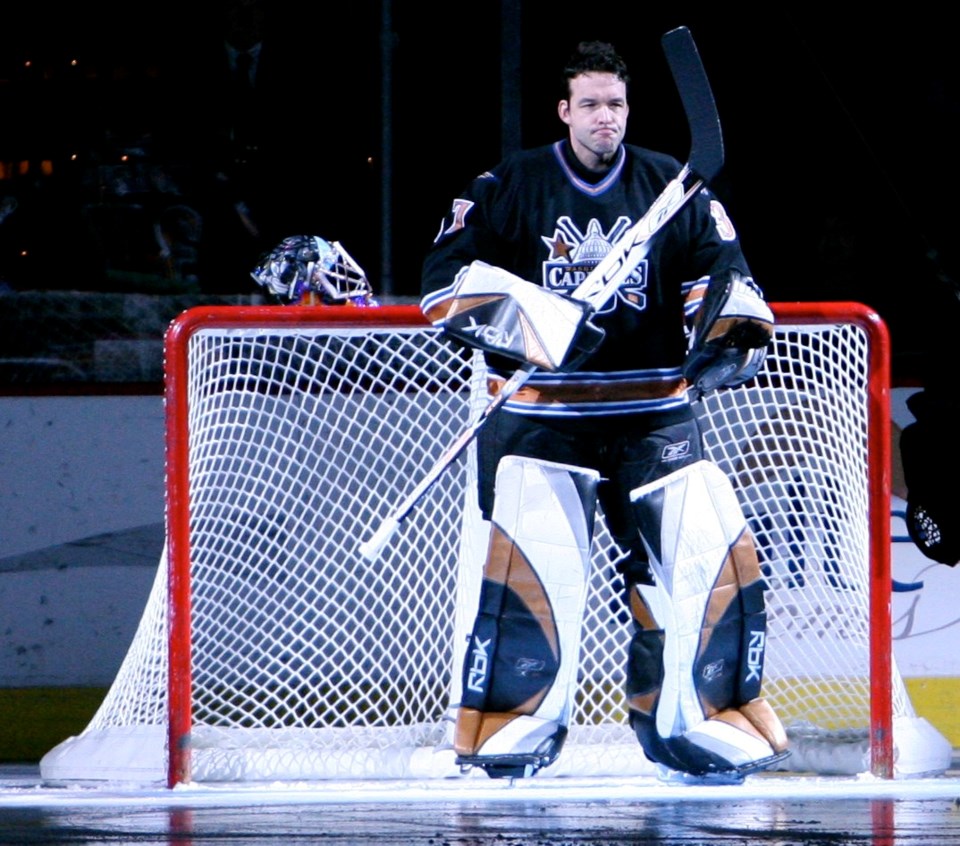The Paper Feature is a weekly column and sidebars that appears in the Vancouver Courier newspaper. Track it down!
Jacob Markstrom and Anders Nilsson have a lot in common. They’re both 6’6”, born just a few months apart 27 years ago in Sweden, and have struggled as backups in the NHL. The Canucks need one of them to step up as a number one goaltender for the first time in their careers.
“You don’t really know with a goalie until they’re 26-27 years old what they’re going to develop into,” said Canucks General Manager Jim Benning. As evidence, he pointed to Dominik Hasek.
The Sabres traded for Hasek when he was 27. The next season, he truly became the Dominator, posting a league-best .930 save percentage and winning his first of six Vezina trophies.
The trouble with looking at a generational talent like Hasek is that it can lead you astray. Statistical analysis by Sportsnet’s Stephen Burtch indicates that the average NHL goaltender starts to decline at the age of 26 and, on average, goaltenders actually peak at around 22 or 23. There are very few goaltenders who became legitimate number ones after turning 26.
The Iron Curtain, not their ability, kept Hasek and Roman Cechmanek out of the NHL. Limited opportunities in the Original Six era meant Johnny Bower was 33 when he became the Leafs number one. A few other examples — Tim Thomas, Niklas Backstrom, Craig Anderson, and Manny Legace — don’t really fit Markstrom or Nilsson’s career path.
There is a best case scenario for the Canucks’ two 27-year-old goaltenders, however: Olaf Kolzig.
Like Markstrom and Nilsson, Kolzig was a big goaltender — 6’3” was considered massive at the time, earning him the nickname Godzilla for his size (and quick temper) — and he struggled as an NHL backup for years.
At 27, he was slated to backup Bill Ranford for the Washington Capitals after they traded the Vezina-winning Jim Carey to the Bruins, but Ranford went down with an injury in the first game of the season. Kolzig took over and took off, posting a stellar .920 save percentage in the regular season, then carried the Capitals to their only Stanley Cup Finals appearance in franchise history, with a ridiculous .941 save percentage and four shutouts.
A year later, he won the Vezina as the league’s top goaltender.
That would be an ideal, if unlikely, path for either Markstrom or Nilsson to take: Stanley Cup Finals in 2017-18 and a Vezina in 2018-19. But how did Kolzig go from a below-average backup to one of the best starters in the league?
Kolzig credits his goaltender coach, Dave Prior, newly hired by the Capitals that season, saying, “He was able to get me on track on a more consistent basis.”
Hiring Prior isn’t a possibility — he works for the Vegas Golden Knights — but the biggest adjustment he made with Kolzig is within reach. Kolzig’s biggest issue was mental, not physical, and Prior got him on a more even keel.
Markstrom has struggled with consistency in the past, but the season opener, he impressed with his mental toughness, bouncing back from letting in a goal on the very first shot of the season. If that’s a sign of his mental strength, maybe there’s still hope he can make that jump at 27.
Stick-Taps and Glove-Drops
A tap of the stick to Travis Green. Though I don’t agree with the coach’s decision to make Brock Boeser a healthy scratch for the first two games of the season, he explained his rationale for doing so in a reasonable, logical manner. There’s every indication from the players that Green explains things to them just as reasonably, making it easy to know where you stand. While you can argue Boeser should have been playing from day one, Green will make a sound argument in response.
I’m dropping the gloves with the Canucks prospect development crew, because they were unable to get Jonathan Dahlen reunited with Elias Pettersson in the Swedish Hockey League this season. The two top Canucks’ prospects were dominant in Sweden last season, but they will play for different teams this season as Dahlen returns to Sweden instead of sticking in the AHL. It might have been out of their hands, but it seems like a missed opportunity to not have them further develop their chemistry together.
Game of the Week: October 19th at Boston
While games against the Boston Bruins will never be as big as they were in the season after the 2011 Stanley Cup Finals — Cody Hodgson’s bar down slap shot goal in “Game 8” continues to reverberate — a trip to Boston still brings back memories and bad feelings. Sure, there are fewer familiar faces from their Finals matchup, but Brad Marchand is still there, as are Zdeno Chara and Patrice Bergeron, among others.
In addition, if Brock Boeser is in the lineup, it’ll be the meeting of two potential Calder candidates, as the Bruins boast Charlie McAvoy on the blue line.



